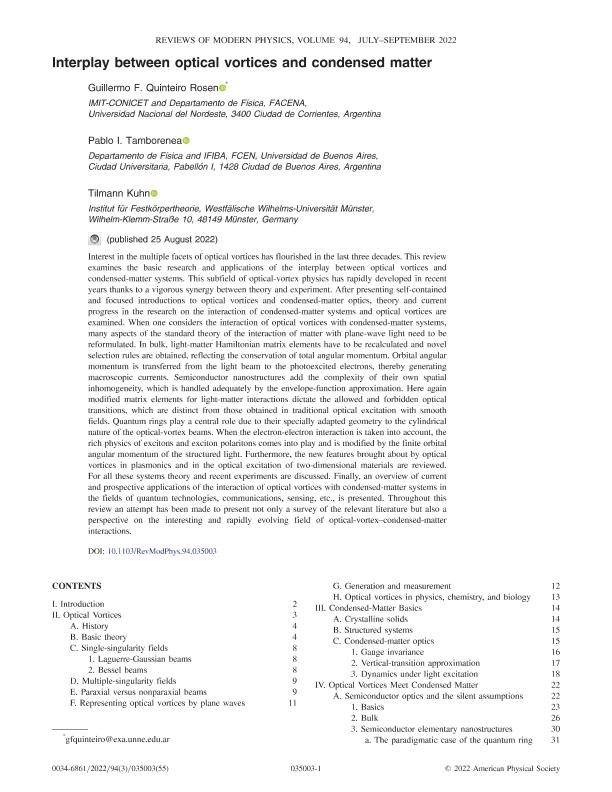Artículo
Interplay between optical vortices and condensed matter
Fecha de publicación:
07/2022
Editorial:
American Physical Society
Revista:
Reviews Of Modern Physics
ISSN:
0034-6861
Idioma:
Inglés
Tipo de recurso:
Artículo publicado
Clasificación temática:
Resumen
Interest in the multiple facets of optical vortices has flourished in the last three decades. This review examines the basic research and applications of the interplay between optical vortices and condensed-matter systems. This subfield of optical-vortex physics has rapidly developed in recent years thanks to a vigorous synergy between theory and experiment. After presenting self-contained and focused introductions to optical vortices and condensed-matter optics, theory and current progress in the research on the interaction of condensed-matter systems and optical vortices are examined. When one considers the interaction of optical vortices with condensed-matter systems, many aspects of the standard theory of the interaction of matter with plane-wave light need to be reformulated. In bulk, light-matter Hamiltonian matrix elements have to be recalculated and novel selection rules are obtained, reflecting the conservation of total angular momentum. Orbital angular momentum is transferred from the light beam to the photoexcited electrons, thereby generating macroscopic currents. Semiconductor nanostructures add the complexity of their own spatial inhomogeneity, which is handled adequately by the envelope-function approximation. Here again modified matrix elements for light-matter interactions dictate the allowed and forbidden optical transitions, which are distinct from those obtained in traditional optical excitation with smooth fields. Quantum rings play a central role due to their specially adapted geometry to the cylindrical nature of the optical-vortex beams. When the electron-electron interaction is taken into account, the rich physics of excitons and exciton polaritons comes into play and is modified by the finite orbital angular momentum of the structured light. Furthermore, the new features brought about by optical vortices in plasmonics and in the optical excitation of two-dimensional materials are reviewed. For all these systems theory and recent experiments are discussed. Finally, an overview of current and prospective applications of the interaction of optical vortices with condensed-matter systems in the fields of quantum technologies, communications, sensing, etc., is presented. Throughout this review an attempt has been made to present not only a survey of the relevant literature but also a perspective on the interesting and rapidly evolving field of optical-vortex-condensed-matter interactions.
Palabras clave:
optical vortices
,
semiconductors
,
nanostructures
,
light-matter interaction
Archivos asociados
Licencia
Identificadores
Colecciones
Articulos(IFIBA)
Articulos de INST.DE FISICA DE BUENOS AIRES
Articulos de INST.DE FISICA DE BUENOS AIRES
Articulos(IMIT)
Articulos de INST.DE MODELADO E INNOVACION TECNOLOGICA
Articulos de INST.DE MODELADO E INNOVACION TECNOLOGICA
Citación
Quinteiro, Guillermo Federico; Tamborenea, Pablo Ignacio; Kuhn, Tilmann; Interplay between optical vortices and condensed matter; American Physical Society; Reviews Of Modern Physics; 94; 3; 7-2022; 1-55
Compartir
Altmétricas




